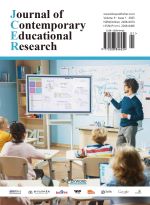Integrating Digital Humanities into Senior High School Literary Criticism: Opportunities and Challenges
Abstract
In the present day, digital methods aid in the investigation and reflection of language and literary studies. It continues to develop through the use of digital tools, providing fresh perspectives on text analysis, language comprehension, and cultural significance of literary works. The growing field of digital humanities has completely changed how academics study and comprehend language and literature. The goal of digital humanism is to investigate how technology and humanistic research might be combined in the field of language and literary studies. It demonstrates how technology improves our understanding of stories, genre classification, authorship characteristics, and language evolution. Furthermore, using these digital tools goes beyond simple analysis, embracing fresh approaches to interpretation and providing new perspectives on the production, distribution, and reception of literary works and linguistic materials. It provides opportunities for interdisciplinary study by fusing computational techniques with humanities studies to investigate language and literature in fresh and perceptive ways. In the literary field, the digital humanities offer cutting-edge techniques and resources that enhance study, instruction, and interpretation. In addition to advancing conventional approaches, the function of digital humanities is to promote innovative approaches to engage with and understand cultural artifacts in a technologically mediated world.
References
Berry DM, 2019, What Are the Digital Humanities? viewed December 23, 2024, https://www.thebritishacademy.ac.uk/blog/what-are-digital-humanities/
Digitalna Humanistika, 2020, viewed December 23, 2024, https://sl.wikipedia.org/wiki/Digitalna_humanistika
Gavin M, Smith KM, 2012, An Interview with Brett Bobley, in Gold MK (Ed.), Debates in the Digital Humanities, University of Minnesota Press, London, 61–66.
Harrison E.], McTavish M, 2018, ‘i’Babies: Infants’ and Toddlers’ Emergent Language and Literacy in a Digital Culture of iDevices. Journal of Early Childhood Literacy, 18: 163–188.
Shahgiraev IU, Dzhafarova ZK, Hadisov MRB, 2022, Economic Security of Enterprises Amidst Digital Transformation of Economy, Social and Cultural Transformations in the Context of Modern Globalism, Grozny, Chechen Republic, Russia, 545–552.
Pusvyta S, 2015, Memotivasi Belajar dengan Menggunakan E-Learning. Jurnal Ummul Quro, 6(2): 20.
Volchik VV, 2019, Institutional Traps in the Education and Science Sector under the Conditions of Optimisation. Zhurnal Economicheskoj Teorii, 16(4): 783–795.
Walt A, Steyn J, Trusler A, et al., 2023, Challenges and Opportunities of Digital Humanities Training in South Africa, Digital Humanities Workshops, Routledge.
Turula A, 2017, Learner Autonomy as a Social Construct in the Context of Italki. Teaching English with Technology, 17(2): 3–28.
Mudra H, 2020, Digital Literacy Among Young Learners: How Do EFL Teachers and Learners View Its Benefits and Barriers? Journal of Teaching English with Technology, 20(3): 3–24.
Bekker T, Bakker S, Douma I, et al., 2015, Teaching Children Digital Literacy Through Design-Based Learning with Digital Toolkits in Schools. International Journal of Child-Computer Interaction, 5: 29–38. https://doi.org/10.1016/j.ijcci.2015.12.001
Mohammadyari S, Singh H, 2015, Understanding the Effect of E-Learning on Individual Performance: The Role of Digital Literacy. Computers & Education, 82: 11–25. https://doi.org/10.1016/j.compedu.2014.10.025
Fieldhouse M, Nicholas N, 2008, Digital Literacy as Information Savvy: The Road to Information Literacy, in Knobel M, Lankshear C, (Eds.), Digital literacies concepts, policies and practices, 43–72.
Jain NJ, 2023, What Is Qualitative Research Design? Definition, Types, Methods and Best Practices. IDEASCALE, viewed December 23, 2024, https://ideascale.com/blog/what-is-qualitative-research/
Crosley J, 2021, What (Exactly) Is Thematic Analysis? GRADCOACH, viewed December 23, 2024, https://gradcoach.com/what-is-thematic-analysis/

